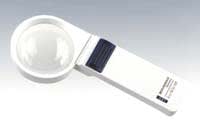|
|
|
|
Zeiss teleloupe spectacles. Photo courtesy of Vision Advantage |
LOW
VISION
An inside Look
By Steph De Long
In the June supplement, Focus on Low Vision, we presented just a few of the findings of a phone survey conducted exclusively for Eyecare Business. In this month�s column, we�ll take a broader look at the results.
The goal of this survey? To find out how �general practice� optometrists who have recently added low vision to their practices view the category. Though we contacted hundreds of practices, we actually surveyed 50 of them in April. To meet our criteria, each practice had to meet three requirements. First, it needed to have added low vision within the last five years. Two, it needed to have added it as an adjunct to an existing practice. And, three, it needed to be involved in dispensing low vision devices as well as seeing low vision patients.
As reported in Focus on Low Vision, there�s been a definite rise of interest in low vision over just the last few years. In fact, nearly half of those surveyed, 48 percent, have added low vision in just the past two years.
Low Vision�s Draw
Why did they get involved? Six out of 10 report their main reason was to set apart or increase the reach of their practices. Here�s a closer look at doctors� reasons.
� 62%...to differentiate their practice
� 18%...the income that low vision services could provide
� 12%...social or moral obligation
� 6%...because of the personal experiences of someone they know or are related to
As for training, some say courses in optometry school addressed low vision. Several recent grads said they thought they knew enough to get started. A couple said they would be working closely with area ophthalmologists and so did not require any additional training. More than 15 percent, however, indicated they felt it was imperative to get more current preparation before venturing into the category. Where did they get that training?
� 40%...seminar by vendor or at trade show
� 36%... courses at non-profits and universities
� 8%...retained a low vision consultant
Looking back on their decision to add low vision to their practices, most O.D.s we surveyed agree it was a positive move. Their reasons for staying with it varied, however. Here�s what they said:
� 48%...it�s a �feel good� specialty
� 24%...low vision has succeeded in setting them apart
� 22%...increased business
Its Challenges
|
|
|
|
LED illuminated magnifier by Eschenbach Optik of America |
|
Asked about the negatives of getting involved in low vision, most everyone cited lack of reimbursement as the toughest pill to swallow. They also pointed to two other negatives�limited referrals and the fact that caring for low vision patients is so time intensive. In fact, doctors reported that they spend more than twice as much time with their low vision patients as with their regular patients.
Where do they find these patients? All suggest it is a combination of factors that bring new patients to them.
� 26%...word-of-mouth
� 18%...community outreach
� 18%...advertising
� 14%...all seem equally important
Dispensing Devices
Asked if they dispense devices, only six percent say they do not. A total of 38 percent report they dispense magnifiers and monocular telescopes only, while 46 percent also prescribe optical aids that include low vision spectacles. Only 16 percent offer all types of devices, including video magnifiers and independent living aids.
Though most agree devices are key to turning a profit, we asked, �What is the most important thing you need to do to make the low vision portion of your practice more profitable?� Here�s how they answered:
� 40%...manage chair and staff time
� 18%...get the word out and market devices better
� 17%...develop a stronger referral base
Looking ahead, most see the projected increase in low vision patients as a plus. Most also agree that the biggest benefit will be a better return on their investment over the next several years. Here�s what they said about the likely impact on optometry of increasing interest in the category.
� 52%...better return on investment for those already in low vision
� 18%...forced to do a better job in the category
� 12%...increase in competition from other ODs getting into low vision
Looking beyond competition from within, however, many of those surveyed say that there will also be more outside providers, including contract service providers and more retail-oriented dispensing businesses.
And, they add, pressure will be on to do a better job�both as individuals and as a profession. If they don�t, half of those surveyed agreed there are a lot of other players waiting to fill the void.





